Looking to build a bigger, stronger chest? Barbell chest workouts are a great way to do it.
In this guide, I’m sharing my 10 favorite (based on science and experience) barbell chest exercises that will pack on serious mass and strength.
But why is the barbell chest workout so important?
They are a great way to build a strong, muscular chest. They allow you to lift heavier weights than you could with cable or dumbbell chest exercises, stimulating more muscle growth.
Here, we’ll look at the best barbell exercises for your chest, how to do them safely and effectively, and how to add them to your training plan.
Let’s get started.
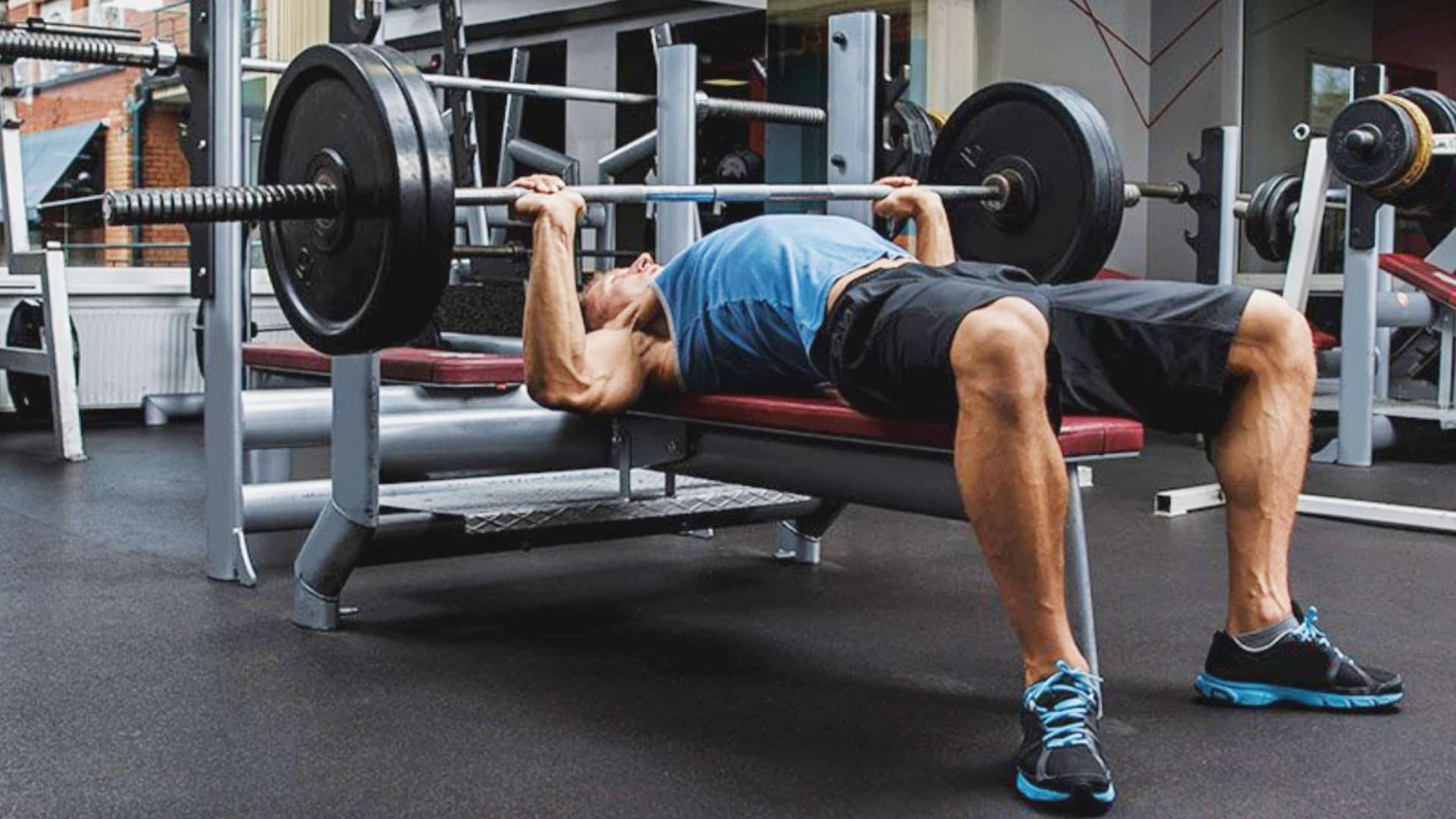
- How To Do A Chest Workout With Barbell
- 10 Best Barbell Chest Exercises To Build Mass and Strength
- 1. Barbell Bench Press
- 2. Incline Bench Press
- 3. Barbell Decline Press
- 4. Barbell Pullover
- 5. Reverse Grip Bench Press
- 6. Incline Reverse Grip Bench Press
- 7. Close-Grip Bench Press
- 8. Landmine Chest Press
- 9. Landmine Floor Chest Fly
- 10. Barbell Floor Press
- Barbell Chest Workout Routines
- Optimize Training Volume
- Beginner-Friendly Barbell Chest Workout Routines
- Advance Barbell Chest Workout Routine
- FAQs
- Are barbells better than dumbbells?
- How Often Should You Train Your Chest?
- Takeaways
How To Do A Chest Workout With Barbell
Barbells are more stable and can lift more weight than dumbbells, which is why they are generally more effective at building chest strength.
Almost all gyms have all the equipment you need to start doing barbell chest exercises. If you have a bench, you can do barbell workouts at home.
Some of the most popular barbell chest exercises include the incline bench press, flat bench press, close-grip bench press, and reverse-grip bench press. Barbell chest presses also work your shoulders and triceps, which is a bonus.
To structure an effective chest workout with a barbell to increase mass and strength, the number of reps and sets will vary based on your fitness level, weekly workout frequency, and strength training goals.
- For strength gains, do 4 to 6 sets of 1 to 6 reps with a weight at least 85% of your one-repetition maximum (1RM) The fewer reps you perform, the closer to 100% of your 1RM you should strive for.
- If your goal is hypertrophy (muscle growth), perform 3–4 sets using loads 70 to 85% of your 1RM for 8 to 12 reps.
- When training for endurance, it is usually recommended to use higher reps (15 to 20 repetitions) with moderate loads of at least 50 to 70% of your 1RM.
10 Best Barbell Chest Exercises To Build Mass and Strength
Here is the list of the 10 best chest barbell exercises, which help train the chest at various angles, strengthen it, and build a well-developed chest.
1. Barbell Bench Press
The barbell bench press is a popular chest exercise in weightlifting circles. It should be the central part of your barbell chest workouts.
The flat bench press is a compound exercise that simultaneously works for multiple muscle groups. It primarily targets the pectoral muscles (chest) but also engages your shoulders, triceps, and even your core to some extent.
It is the fundamental exercise for the upper body and should be a part of any best chest exercise regime. That’s why the barbell chest press is always at the top of the list for chest development.
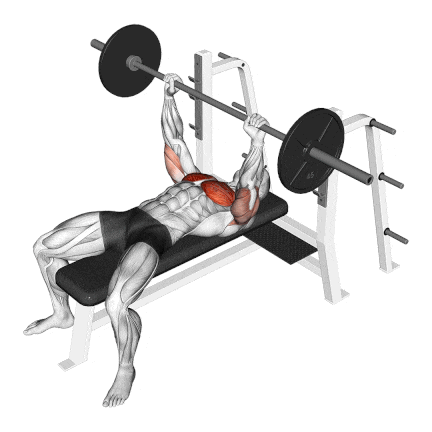
How To Do
- Lie flat on the bench and keep your feet on the floor for better balance.
- Retract scapulae, keep wrists straight, and grip just outside shoulder-width.
- Unrack the barbell and hold it above your chest with extended arms.
- Now lower the bar under controlled motion until it touches above the chest (around the nipple area).
- Raise it until your arms are nearly locked out. Do not bounce the weights off the chest.
- Keep a controlled motion and avoid jerky movements.
2. Incline Bench Press
The Incline barbell bench press is a version of the traditional bench press in which the bench is positioned at a 30-45-degree angle.
The Incline bench press exercise focuses on the upper chest and helps build a massive chest. The incline angle also allows for greater activation of the anterior deltoids (front shoulder muscles).
The study found that the most activity for the upper part of the pectoralis major muscle occurred when the bench was angled at 30 degrees.
Experiment with different incline angles to find what targets your upper chest most effectively—usually, a 30-45 degree angle works well for most people.
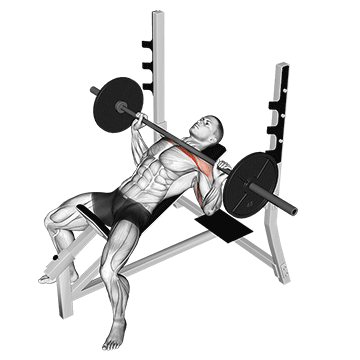
How To Do
- Adjust the bench at an incline angle between 30 and 45 degrees. (Do not go more upright, as the stress shifts more to the shoulders rather than the chest area.)
- Lie back on the bench with your feet flat on the floor for stability.
- Grip the barbell slightly wider than shoulder-width apart. Ensure your wrists are straight and your grip is firm.
- Your elbows should be angled slightly toward your torso (about 45 degrees from your body) rather than flare them out.
- Lift the weight off the rack and hold it at arm’s length above you.
- Lower the bar until it just touches above the nipple area.
- Exhale and press the barbell back up to the starting position. Raise your arms until they are nearly locked out.
3. Barbell Decline Press
The barbell decline bench press is excellent for strengthening your lower chest muscles. It’s a variation of the flat bench press, a popular chest workout.
In a decline chest press, the bench is set to 15 to 30 degrees on a decline. This angle places your upper body on a downward slope, which activates the lower pectoral muscles as you push weights away from your body.
The decline angle places less stress on the shoulders and reduces the risk of shoulder strain and allows you to lift heavier weights.
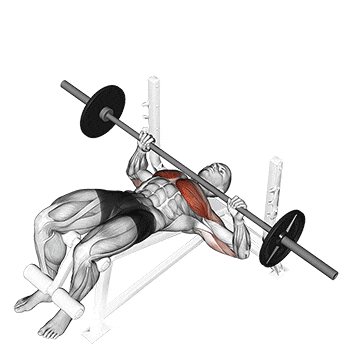
How To Do
- Lie back on a decline bench with your feet on padded supports.
- Make sure your feet and legs are securely hooked under the leg brace
- Grasp the barbell with a grip slightly wider than shoulder-width apart.
- Unrack the barbell and hold it above your lower chest with extended arms.
- Slowly lower the barbell towards your lower chest.
- Push the barbell back up to the starting position. Avoid locking your elbows at the top.
4. Barbell Pullover
If you’re looking for a way to get more creative with your barbell chest workout, why not try a barbell pullover exercise?
The barbell pullover is a compound exercise that works multiple muscle groups simultaneously. It helps build a strong rib cage and serratus anterior muscle to build a complete chest and back.
When done correctly, it also helps to increase flexibility and range of motion in the chest and shoulders.
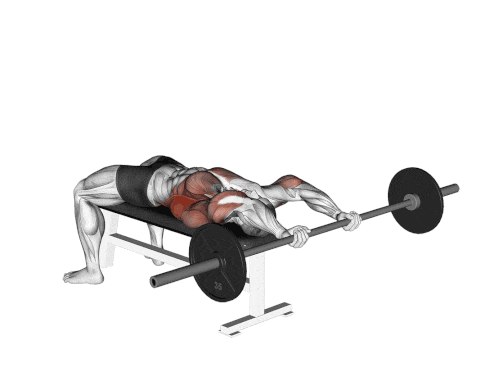
How To Do
- Lie on a bench so that only your upper back and shoulders are supported. (or lie on the complete bench)
- Grasp a barbell with both hands and get it straight over your chest. Maintain a slight bend in your elbows.
- Lower the barbell in an arc slowly, getting a good stretch in your rib cage. Lower the barbell as far as possible.
- Pull the barbell back over your chest until your arms are fully extended.
- Complete your desired number of repetitions and sets.
5. Reverse Grip Bench Press
The reverse-grip bench press is a variation of the traditional bench press. In it, you use an underhand grip (palms facing you).
It is a compound exercise that simultaneously works for multiple muscle groups. In addition to targeting the chest, reverse grip bench presses also train the triceps, anterior deltoids, and serratus anterior.
A reverse grip hits the tricep muscles more than the regular bench press. One study has shown that it is one of the best exercise modifications for standard bench presses to prevent and train around shoulder pain.
Remember: Using anything closer than a shoulder-width grip increases triceps involvement but can increase stress on the wrists.
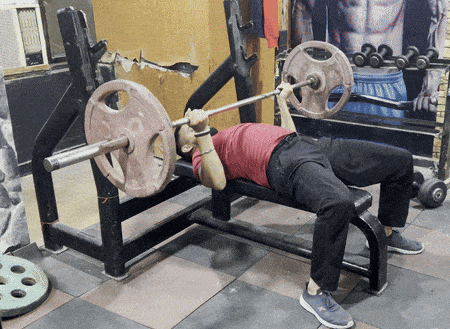
How To Do
- Lie flat on a bench with your feet flat on the floor.
- Grip the barbell with an underhand grip slightly wider than shoulder-width apart.
- Retract your shoulder blades and pull your shoulders down towards your back pockets.
- Unrack the bar and slowly lower it to your lower chest.
- At the bottom of the movement, your elbows should be a little lower than your shoulders.
- Exhale and push the bar back up to the starting position.
- Inhale slowly as you lower the bar to your chest, and exhale during the push upward.
6. Incline Reverse Grip Bench Press
A reverse-grip Inline bench barbell press actually shifts the most focus to the upper pecs. Start out light, and make sure your thumbs are hooked around the bar for safety.
The reverse-grip bench press may not seem like an upper chest move, but it is an upper pec exercise, as explained in this exercise anatomy.
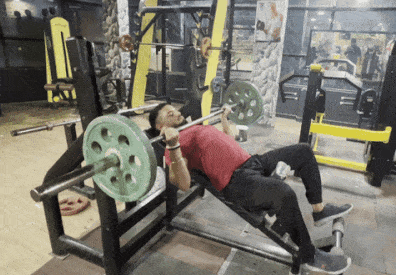
How To Do
- Lying on a flat bench, grasp the bar with a supinated (reverse) grip, shoulder-width apart, and thumbs around the bar.
- With your elbows tucked in close to your sides, slowly lower the bar down to your lower pecs.
- Press the bar back up to the start position in a slight backward arc without letting your elbows flare out.
- Don’t lock out your elbows at the top of the rep; keep a bend in your arms, maintaining control of the weight at all times.
Know More: Chest Dumbbell Fly: Muscle Worked, Foam, Alternative
7. Close-Grip Bench Press
The close grip bench press is an often overlooked but incredibly effective exercise targeting chest and tricep muscles.
Unlike the traditional bench press, which primarily targets the chest muscles, the close grip version focuses more on the triceps and the inner chest.
In a close-grip bench press, the hands are placed closer together on the barbell, typically around shoulder-width apart or slightly narrower.
This exercise is another great option for targeting the chest and triceps and growing your upper body.

How To Do
- Lie flat on a bench-press bench with your feet flat on the floor.
- Grip the barbell with your hands placed closer than shoulder-width apart.
- Engage your core and arch your back slightly, creating a natural curve in your spine.
- Unrack the bar and hold it directly above your chest.
- Inhale as you slowly lower the bar down toward your chest.
- Press the bar back up to the starting position.
- Inhale slowly as you lower the bar to your chest, and exhale during the push upward.
8. Landmine Chest Press
If you’re looking for a way to get more creative with your inner chest workout, why not try the Landmine barbell chest press exercise?
You can do the landmine chest press with a barbell and equipment called a landmine. One end of the barbell is connected to the landmine, which secures the barbell to the floor. You hold the other end of the barbell at chest level.
It is my favorite exercise to train the upper and inner portions of the chest.
You can do it in a standing or kneeling position. Both effectively train the chest and engage the core muscles.
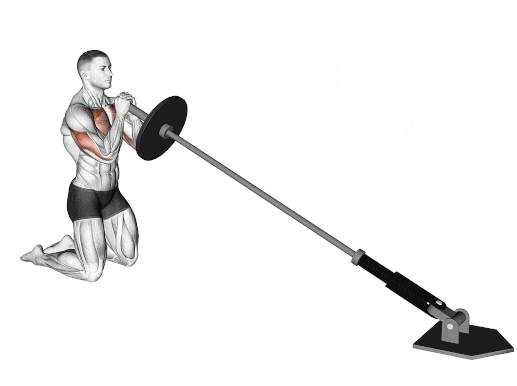
How To Do
- Place a barbell in a landmine holder or set it up in a corner. Then, add weight plates to the free end of the barbell.
- Assume a half kneeling position with the knee under your hip, toes tucked, and rib cage down.
- Grab the barbell with both hands. To secure the barbell, you can interlock your hands around the bar.
- Lean your body forward slightly and engage your core muscles to help with stabilization.
- Press the barbell up straight in front of you until your arms are fully extended.
- Hold the weight for a second and focus on contracting your chest muscles.
- Slowly lower the weight back towards your chest and then repeat for the recommended reps
Know More: Landmine Exercises For Building Muscle And Strength
9. Landmine Floor Chest Fly
The landmine floor one arm chest fly is a unilateral exercise that targets the chest, shoulders, and triceps muscles.
The Landmine Floor Chest Fly emphasizes the pectoralis major, particularly the sternal head. Its arc motion stretches and contracts the chest muscles through a significant range of motion, promoting hypertrophy.
You can perform it on a bench or the floor. The floor acts as a limiting factor, preventing excessive range of motion that can strain the shoulder joints.
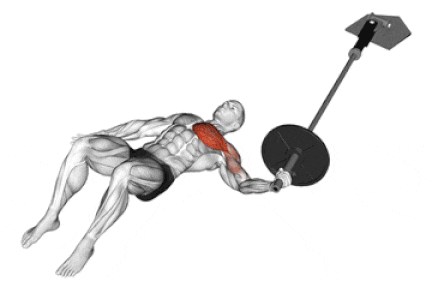
How To Do
- Place one end of the landmine barbell in the corner of a room, or use a landmine attachment.
- Use a lighter weight to ensure proper form and avoid strain on your shoulder joint.
- Lie on the floor with your head facing the landmine attachment and grab the other end of the bar with one hand.
- Extend your arm and keep it straight up with the palm facing inward.
- Lower the arm down and out to the side in a controlled manner until you feel a stretch in your chest.
- Contract your chest muscles to return your arm to the starting position.
10. Barbell Floor Press
Since the floor press starts from a dead stop at the bottom, it helps improve lockout strength. This is especially useful for powerlifters and athletes looking to increase their bench press performance.
The floor press limits shoulder extension, reducing the risk of shoulder impingement and other injuries.
The reduced range of motion prevents the shoulders from becoming overextended, which can benefit those with shoulder issues or limited shoulder mobility.
You can perform it with minimal equipment, which makes it accessible for home workouts or gyms with limited resources.
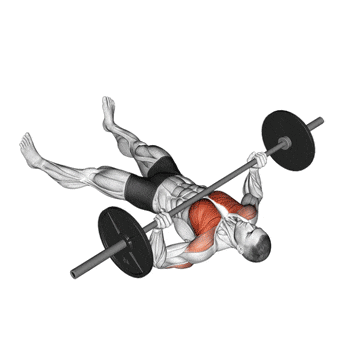
How To Do
- Lie on your back on the floor, with your legs bent and feet flat on the ground or straight leg.
- Position the barbell on a rack or use a partner to help lift it into position.
- Grab the barbell with a grip slightly wider than shoulder-width apart.
- Ensure your elbows are locked out, and your shoulders are firmly pressed into the floor.
- Control the descent and bring the barbell down until your upper arms lightly touch the floor.
- Press the barbell back up to the starting position by extending your elbows and pushing through your triceps and chest.
Barbell Chest Workout Routines
It’s important to focus on training volume and technique to train the chest effectively. Here’s what you need to know:
Optimize Training Volume
Training volume refers to the total work you perform during a workout, including the number of sets, reps, and weights.
Of course, your fitness journey will determine the number of sets and reps, but this is a great starting point.
Sets
According to the latest scientific evidence, 12–20 weekly sets per muscle group may optimize muscle growth.
- Beginners (with a year or less of training) should aim for about 12 weekly sets.
- An Intermediate trainee (with two to four years of training) can increase the volume to 16 sets per week.
- An advanced trainee (four or more years of training) may be able to get in up to 20 weekly sets.
When a certain amount of volume stops being effective and your progress stalls, you can add sets to increase volume and use that as a driver of renewed progress.
Reps
The best rep ranges and loads to work with.
- For muscle endurance: Aim for 15-20+ reps with moderate resistance.
- For muscle strength: 6-10 reps, with more resistance.
- For muscle hypertrophy (increased muscle size): Aim for 3-4 sets of 8-12 reps, with moderate to heavy resistance.
It’s best to start with fewer reps and sets at first and then increase them as you get stronger.
Beginner-Friendly Barbell Chest Workout Routines
The following chest workout is highly effective and would show results with proper technique and sequence.
| Exercise | Sets | Reps |
|---|---|---|
| Flat Bench Press | 4 | 6-8 |
| Inline Bench Press | 4 | 8-10 |
| Barbell Pullover | 3 | 10-12 |
Advance Barbell Chest Workout Routine
This advanced barbell workout makes it slightly more challenging for a beginner.
| Exercise | Sets | Reps |
|---|---|---|
| Decline Bench Press | 4 | 8-10 |
| Incline Barbell Press | 4 | 10-12 |
| Reverse Grip Press | 4 | 10-12 |
| Landmine Chest Press | 3 | 8-10 |
Note: To effectively train the muscle group, you must use various equipment (dumbbells, cable, bodyweight) and techniques.
Chest Workout Using Different Equipment:
- 10 Best Chest Workout With Dumbbells
- Best Cable Chest Exercises And Workout Routine
- Bodyweight Chest Exercises: Beginner To Advance
Perform a good warm-up using a lower-stress movement, such as the incline push-up, to prepare your body for heavier loads and decrease the risk of injury.
FAQs
Are barbells better than dumbbells?
It is statistically proven that most people will be 20% stronger when using barbells for the same exercise. Most people will also find it easier to progress with barbells than dumbbells.
How Often Should You Train Your Chest?
Ultimately, your results will depend on your ability to recover adequately from your workouts. To allow sufficient recovery, it is recommended that you allow at least 36 to 48 hours of rest before training the same muscle groups again. It is also advised that you do not train the chest more than two times per week.
Takeaways
If you want to train the muscle group totally, you’ll need to try other exercises using a range of equipment and techniques.
Variety is one of the significant keys to muscle adaptation, so challenging your chest in different ways will be a key driver for growth.
The above barbell chest exercises, along with a high-protein diet, may help increase the size and strength of these muscles.
References
- Rodríguez-Ridao, David, et al. “Effect of Five Bench Inclinations on the Electromyographic Activity of the Pectoralis Major, Anterior Deltoid, and Triceps Brachii during the Bench Press Exercise.” International Journal of Environmental Research and Public Health, vol. 17, no. 19, 8 Oct. 2020, p. 7339, https://doi.org/10.3390/ijerph17197339.
- Sheikholeslami-Vatani, Dariush, et al. “Comparison of the Effects of Resistance Exercise Orders on Number of Repetitions, Serum IGF-1, Testosterone and Cortisol Levels in Normal-Weight and Obese Men.” Asian Journal of Sports Medicine, vol. 7, no. 1, 1 Mar. 2016, https://doi.org/10.5812/asjsm.30503.

Manish is a NASM-certified fitness and nutrition coach with over 10 years of experience in weight lifting and fat loss fitness coaching. He specializes in gym-based training and has a lot of knowledge about exercise, lifting technique, biomechanics, and more.
Through “Fit Life Regime,” he generously shares the insights he’s gained over a decade in the field. His goal is to equip others with the knowledge to start their own fitness journey.
